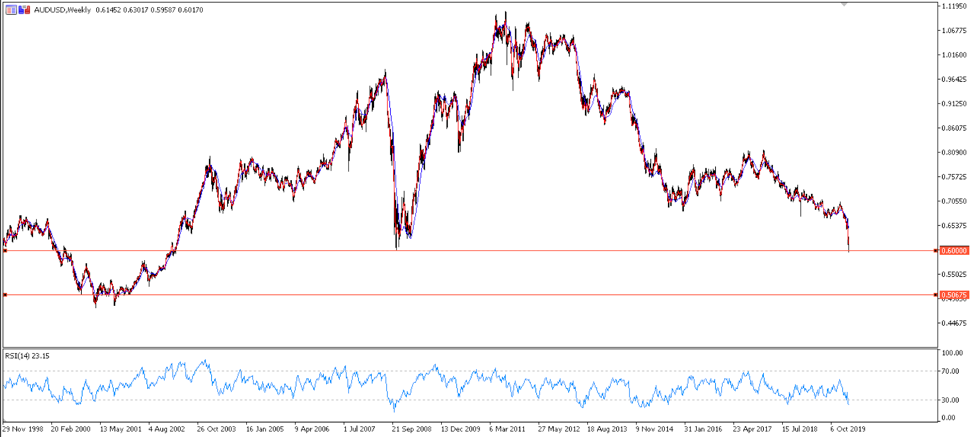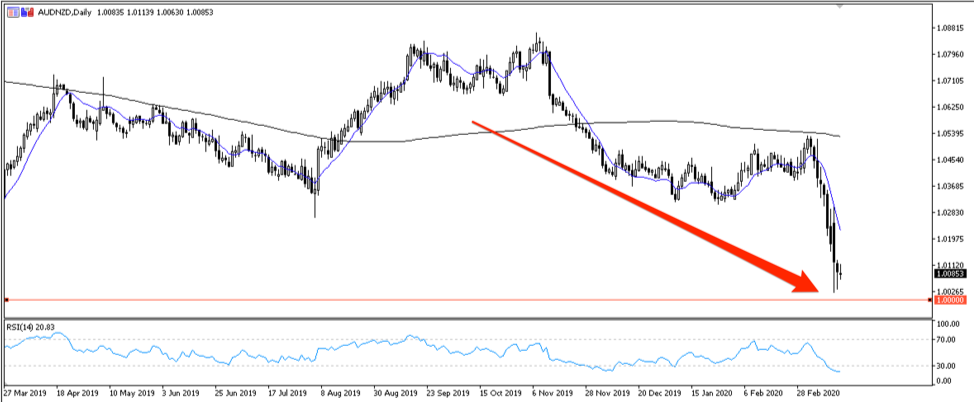CFDs are complex instruments and come with a high risk of losing money rapidly due to leverage. 72.2% of retail investor accounts lose money when trading CFDs with this provider. You should consider whether you understand how CFDs work and whether you can afford to take the high risk of losing your money.
- English
- Italiano
- Español
- Français
Global risk proxy
The AUDUSD forex pair is a global risk proxy. The Aussie tends to strengthen when the outlook is strong and investors are risk-on, so it also tends to fall when risk aversion kicks in.
The Australian dollar suffered during the GFC. In July 2008, AUDUSD traded as high as 0.9700 before falling to a low of 0.6007 just three months later. In yesterday’s session, AUDUSD closed below GFC lows, levels not seen since April 2003. It’s an ominous sign that the Aussie has further to fall.
Weekly chart: AUDUSD is trading lower than during the GFC. These levels haven’t been seen since 2003, and there’s no strong support until the 50s.

Even more chilling is the lack of support below 0.6000. The weekly chart shows no strong support until the low 50s. Watch for a close below 0.6000. Something that would have seemed far-fetched a few weeks ago, it should serve as confirmation that the Aussie is ready to move lower.
Low energy and commodity prices
Australis is the world’s largest exporter of coal, iron ore, lead, and a raft of other mineral exports. Coal alone makes up 35% of Australia’s exports, with mining comprising 10% of the domestic economy. So it’s no surprise to see AUDUSD drop so quickly as commodity and energy prices fall across the board.
China accounts for almost 70% of global demand growth for commodities, so when the world’s second largest economy stalled during peak coronavirus, it was bad news for commodity prices. But China is slowly getting back to work.
The rest of the world is yet to face peak virus like China has, so there won’t be immediate demand for China’s exports. Yet signs of China ramping up production again could provide relief and a bottom to commodity prices. That improvement should help the Australian dollar too.
USD cash grab
The strong and strengthening US dollar is also working against the AUD.
Investors are in a mad dash to cash as risk aversion ramps up and the crisis intensifies. And in typical crisis fashion, the USD is the place to be despite vigorous rate cuts from the Fed. The US dollar index shows the greenback at its strongest in three years. The theory is the world’s largest economy, which is less dependent on global trade than other major countries, can best withstand the headwinds.
So investors are in a mad dash to cash as risk aversion ramps up, but why? Many reasons. Primarily, it’s a flight to safety, but do consider that cash is needed to cover equity losses and margin calls. Even gold is depreciating as investors liquidate the precious metal to free up cash. Then we face the prospect of another low rate world. The US Federal Reserve slashed interest rates by 150bp in a two-week window to near zero.
The strong USD will continue to weigh on the Aussie and could very well push it beyond 0.6000 into no-mans land. The next few weeks will show where investors decide to store their cash in our low rate world, and as they do demand for the USD should start to cool. When that happens, the AUD will find some relief. Whether it’s enough relief to settle above 0.6000 remains to be seen.
NZD parity
The Aussie has never traded 1:1 with the New Zealand dollar, coming close only once before in 2015. Right now, the antipodean currencies are falling fast, and more downside looms as both central banks approach quantitative easing. NZDUSD closed below 0.6000 in yesterday’s trading for the first time since the GFC.
Daily chart: AUDNZD is approaching parity. The pair has never closed below 1.0000.

Interestingly, although the AUD is now trading below GFC levels, the NZD is far from them. NZDUSD fell below 0.5000 during the GFC, so has 10 US cents to fall before meeting GFC lows just yet.
Parity between the two currencies has never occurred, and would certainly be a big change in dynamic if it happened. I’d expect AUDNZD to continue testing 1.0000 before bouncing off, especially considering the kiwi has plenty of room to fall before hitting GFC lows just yet.
The NZ government impressed with a $12bn fiscal package worth 4% of GDP, larger than the GFC relief package. By contrast, the Morrison government’s economic relief package for Australia amounted to less than 1% of GDP. A second, and more meaningful, stimulus package tomorrow could give AUDUSD some temporary relief, and see AUDNZD bounce off parity for now.
Ready to trade?
It's quick and easy to get started. Apply in minutes with our simple application process.
The material provided here has not been prepared in accordance with legal requirements designed to promote the independence of investment research and as such is considered to be a marketing communication. Whilst it is not subject to any prohibition on dealing ahead of the dissemination of investment research we will not seek to take any advantage before providing it to our clients. Pepperstone doesn’t represent that the material provided here is accurate, current or complete, and therefore shouldn’t be relied upon as such. The information, whether from a third party or not, isn’t to be considered as a recommendation; or an offer to buy or sell; or the solicitation of an offer to buy or sell any security, financial product or instrument; or to participate in any particular trading strategy. It does not take into account readers’ financial situation or investment objectives. We advise any readers of this content to seek their own advice. Without the approval of Pepperstone, reproduction or redistribution of this information isn’t permitted.
